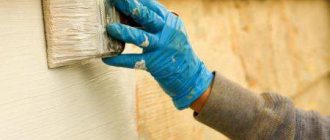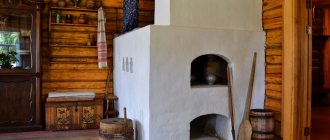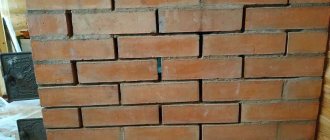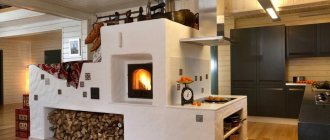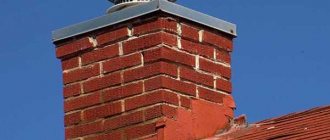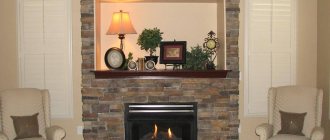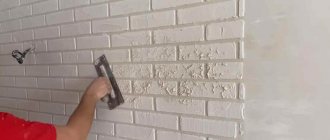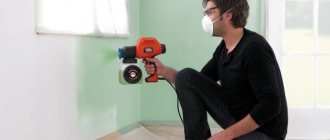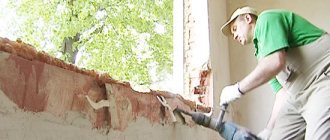Why apply varnish to the stove?
Experienced experts recommend always applying a protective varnish to the brickwork.
This is not only done for the purpose of beautiful design. After all, such a coating is resistant to high temperatures and reliably protects the heating device from mechanical and chemical damage. Transparent heat-resistant varnish for a brick stove has the following advantages compared to other coatings:
- Resistance to high temperatures. Thanks to this characteristic, the varnish coating will last for a long time, despite high temperatures.
- Improves brick resistance to abrasion. The coating on which such a product is applied will be protected from mechanical abrasion.
- Prevents washing out of oven seams.
- Helps strengthen the entire masonry.
- Increases moisture-repellent characteristics. Thanks to this, you do not have to worry about water or other liquid damaging the surface while using the oven device.
- Provides resistance to aggressive substances. Heat-resistant varnish for brick stoves allows you to clean the stove surface from dust, dirt and stains using various detergents. You can be sure that the coating will not be damaged.
- Gives a special shine. Even the color of an ordinary brick can reveal itself in a new way if it is coated with thermovarnish.
Examples of stove varnishing:
Photo 1
Photo 2
What materials are they suitable for?
Modern heat-resistant varnishes are quite suitable for working with the following materials:
- brick (this can be fireclay refractory, decorative or standard brick);
- stone (both natural and artificial);
- ceramics;
- plaster;
- metal (for example, cast iron or steel alloy);
- wood.
It is worth saying more about the choice of heat-resistant composition for wooden surfaces, especially since some stoves and fireplaces may have elements of wooden decor. Particular care must be taken here, since wood without proper protection will catch fire very quickly.
In everyday life, for wooden elements that are not too close to the source of heat and fire, as a rule, they use varnishes that have the second group of fire-retardant efficiency, polyurethane (and polyurethane, as is known, burns only at very high temperatures) compositions for treating furniture and others .
On the other hand, if necessary, you can use a universal heat-resistant varnish, for example, the same KO-85, whose protective properties cannot be doubted. It has the first group of fire retardant efficiency.
This means that the hardened varnish film does not ignite and produces substances that prevent oxygen from entering the inner layers of the wooden product. And the absence of oxygen means the impossibility of combustion.
What kind of varnish can be used to coat a stove?
When choosing, you should pay attention to the following characteristics:
- The heat resistance indicated on the packaging should be approximately 200-250 degrees. Varnish that can withstand temperatures much lower can crack when fired and ruin the coating.
- The packaging must be marked as moisture resistant. In this case, you will protect the oven from mold or mildew.
- Thermovarnish for brick stoves must have a high degree of adhesion. Thanks to this, it penetrates deep into the pores of the brick and provides reliable protection and resistance of the structure to external irritants.
- The varnish must contain acrylic. This will make the layers dry faster.
- The appearance of the varnish is a transparent viscous mass. If the varnish does not have a very transparent structure, then the appearance of the oven device may not change for the better.
There are several varieties of heat-resistant varnishes that have long won the trust of stove and fireplace owners. The most famous such products:
- "KO 85". These products are characterized by a high degree of heat resistance. They can withstand temperatures up to 300 degrees. Thanks to this, their scope of application is not limited to household use: they can also be used in industry for processing various parts of equipment that become very hot. Thanks to the good formula, the composition is homogeneous and easy to apply to the surface using various tools. The service life of such a coating is approximately ten years.
- "KO 815". Heat-resistant varnish that can even be used to paint the internal parts of the stove. It is only heat-resistant, but also frost-resistant. But one of the inconveniences that may arise during the coating process is the mandatory presence of infrared paws. Without their help, the varnish layer will not harden.
- "Siltek-1". A newer coating, which has excellent heat-resistant and moisture-resistant abilities, penetrates well into the pores of the brick. Gives the coating a beautiful even shade and shine. But such a product requires application in three layers, which slightly increases consumption and additional financial costs.
Popular brands:
- TERMO ES-13 “Wet stone”. Packaging – 3 l. Heat resistance up to 300 degrees. Price – from 3000 rub.
- VD-AK-001K “Superdecor”. Weight – 10 kg. Withstands temperatures from -70 to 190 degrees. Price – from 4000 rub.
- Varnish KO-815 “Spectrum”. Weight – 22.5 kg. Withstands temperatures up to 550 degrees. Price from 8000 rub. per package.
- Varnish KO-85 “Spectrum”. Weight – 0.8 kg. Withstands temperatures up to 250 degrees. Service life – up to 15 years. Price – 600 rub.
LM offers for fireplaces from manufacturers
A coating for a stove or fireplaces that can withstand overheating is selected based on the technical characteristics of the compositions, depending on the size of the structures. Manufacturers produce a wide range of paints and varnishes. It is recommended to coat the brick oven with varnish KO 85, KO 815.
Description KO 85
LM KO 85 creates a heat-resistant coating. It is used to protect domestic and industrial heating appliances. The following are painted with an oil product:
- oil, steam, heat pipelines;
- metal structures;
- engine elements that heat up to high temperatures.
Basic components of the composition: organosilicon resins, solvent. This is reflected in the technical characteristics of KO 85:
- resistance to temperatures of 300°C, since resin solutions do not lose their quality under such conditions;
- tolerance to temperature fluctuations from -30°C to +300°C;
- the varnish layer maintains its integrity throughout its entire service life;
- Due to its homogeneous structure, the resin solution evenly covers the surface of brick or metal at temperatures below zero. It does not depend on where the process takes place: outdoors or indoors;
- The material is easy to work with.
It can be applied with any painting tool: roller, brush, spray gun. The varnish composition is checked for viscosity before application. As a result, a light brown protective film is formed. Stove varnish is sold in a tin container, in a 50 kg barrel.
Technical characteristics of KO 815
Tolerates open fire - heat-resistant varnish for stove KO 815. It is used to strengthen brick walls of stoves or fireplaces inside buildings. Its technical characteristics are taken into account:
- the material does not lose its qualities at temperatures: from -60°C to +300°C, therefore they work with it at any air temperature;
- a layer 20-40 microns thick is applied. In this case, LM is consumed in the calculation: 110 g/m2;
- The varnish is transferred from a liquid state to a solid infusible state using the hot method. The technology uses infrared rays (thermoradiation method);
- fire hazard of the coating – class 3 or moderate.
If several protective layers are applied, the effect of the treatment will be maximum. Each layer takes at least minutes to dry. Painted masonry can be fully used after 3 days. LM is sold in containers of 5-50 kg.
Replacement of varnishes KO 85, KO 815 with paint
Siltek-1 paint is used as an alternative heat-resistant material. Before applying it, brick and metal elements are not primed. A layer of paint on the outside of structures tolerates surface heating to high temperatures. A multi-layer coating is applied, at least 3 layers. Paint consumption is calculated at: 300 g/m2. Each subsequent layer is applied after 30 minutes.
To avoid the risk of fire, areas of high heating of the fireplace and stove are treated with heat-resistant varnish compounds.
If heat-resistant materials are applied in compliance with the technology, the protective coating will last a long time, while the aesthetic qualities of the brick will improve.
How to make heat-resistant varnish for the stove with your own hands?
This product does not have to be purchased in a store. You can do it yourself. To do this, you just need to purchase a few components:
- brick dust,
- raw egg white,
- milk.
To create heat-resistant varnish for the stove at home, mix everything in a 1:1 ratio. For 1 sq.m. oven surface you will need about 5-6 egg whites.
Instead of brick polish, you can use tooth powder, this way you will get a white varnish color.
You can apply homemade varnish using a brush, or it is better and more convenient to use a sprayer.
Application algorithm
Before applying heat-resistant varnish, you should take time to prepare the surface. First, you need to remove dirt and dust with a brush, then get rid of oil and other similar stains using household chemicals.
In the room where the work is carried out, the temperature should be from +18° to +25°. In addition, it is necessary to organize its ventilation as part of preparation. Before varnishing, it is also advisable to treat the surfaces of the fireplace or stove with a primer. And only when the primer has dried can you start varnishing.
Carefully open the container with heat-resistant varnish and begin stirring slowly. At the same stage, you can add heat-resistant paint of the desired color (heat-resistant varnishes themselves have a transparent structure). Thus, it is possible to combine varnishing and painting procedures.
Heat-resistant varnish can be applied to metal parts and brickwork with a brush, roller or spray. At the same time, you need to try to prevent the occurrence of drips and air bubbles.
When using a spray gun, the diametric size of the nozzle should be 1.8-2.5 mm, and the distance from the spray nozzle to the surface being treated should be from 20 to 30 cm.
After the first layer has dried, you can reapply the heat-resistant composition to the surface of the fireplace or stove. Usually two or three layers are enough.
Instructions for using varnish
For brick kiln
- Before starting work, you need to prepare the tool. Heat-resistant stove varnish can be applied using a brush or spray. You will also need protective equipment: gloves, a respirator and additional clothing.
- The brick surface must be prepared. To do this, you need to putty all the cracks and irregularities, then remove dust, dirt, and grease from the stove using detergents. Before applying the varnish, you need to thoroughly dry the surface and then treat it with a solvent.
- Next you can start applying the varnish. It is better to follow the instructions on the package. But experts advise applying the composition in several layers. This way you can achieve a perfectly smooth and more reliable coating.
Furnace varnishing
The varnish dries very quickly, but to be safe, it is better to refrain from heating the stove for several days after applying the composition. After applying the composition to the surface, it is recommended to ventilate the room for several hours.
For metal furnaces
If your stove is made not of brick, but of metal, then the coating sequence will be slightly different at the initial stage:
- Clean the surface of the previous coating using a brush or other tools, and only then proceed to solvent treatment.
- Next comes the process of applying varnish in several layers and drying them.
Applying varnish to a metal stove
How to paint stoves
The application of heat-resistant varnish has a lot of subtleties, so many owners of private houses leave such work to professionals. If you wish, you can carry out all the preparatory work yourself. First of all, it is necessary to thoroughly clean the surface of the oven from any contaminants.
If the work is carried out manually, it is best to use a metal brush, as well as a soap solution, which allows you to remove not only dust, but also deep dirt.
If there are deep oily stains on the surface of the brickwork, you can use aggressive cleaning agents, but then be sure to rinse the brickwork thoroughly with clean water.
Thorough pre-cleaning is only the first stage in preparing the surface for application of a primer or special impregnation. For most types of paints and varnishes that are resistant to elevated temperatures, the application of special primers and impregnations is very important. These substances allow you to create excellent adhesion between the brick oven and the varnish. Without applying special compounds, the varnish may soon begin to peel off.
Useful tips when working with varnish
To obtain high-quality adhesion to the surface, several nuances should be taken into account. Optimal temperature conditions are room temperature. Before varnishing, the composition should be thoroughly and slowly stirred. Next, the surface is thoroughly cleaned and degreased. If porous materials are processed, then it is necessary to apply about three layers. Fireplace varnish is also suitable for metal stoves and fireplaces.
It can be used to process cookers and decorative forging products. It is better to store materials in cool places out of direct sunlight.
For better compatibility, it is better to purchase finishing products from one manufacturer. Before working with the material, experts recommend conducting a test first - treating an inconspicuous area and then seeing how the surface will look.
Characteristics of varnish for opening ovens
Brick for stoves has a number of characteristics that allow it to withstand high temperatures while maintaining its properties. During operation, the surfaces of the stove gradually heat up and then release heat to the air, which allows you to create an optimal level of heating in the room. Stove varnish is different from regular varnish. If you try to open a brick stove with regular paint for finishing surfaces inside and outside the room, when exposed to high temperatures, the coating will quickly lose its properties and the stove will take on a sloppy appearance.
Types of heat-resistant varnish
KO-85 is a product whose main component is organic silicon.
One of the most popular types of varnish in the Russian Federation.
Used for application on surfaces made of metal, brick and stone. Adheses well to the base and prevents the formation of corrosion.
KO-85 can be used independently, but for a more durable coating you can combine it with enamel. Can be used at temperatures from -40 to +300°.
The composition of KO-815, like the previous type of varnish, is made on the basis of organic silicon.
It has essentially the same properties, but is distinguished by higher resistance to moisture and the ability to operate at lower temperatures.
In general, the modern market offers consumers a fairly wide selection of heat-resistant varnishes for stoves and fireplaces.
All of them are designed for the same purpose of working with fireplaces, but differ in the specifics of their work and the components they contain.
Before purchasing a stove product, it is recommended that you familiarize yourself with several types from different manufacturers and compare the characteristics.
Main characteristics of fireplace varnish
Typically, the varnish consists of a resin of organosilicon origin, dissolved in a solvent, has special functional additives, a characteristic odor and a transparent consistency. As a rule, the composition is applied in two layers, and its consumption depends on the porosity of the material being coated. Drying time for each layer is from 30 to 50 minutes at a temperature of 18 - 25 degrees.
The varnish, which is used to cover highly heated surfaces and is used under special operating conditions, has the following main characteristics:
- The composition of the varnish withstands thermal changes and is able to withstand high temperatures of up to 200 - 250 degrees.
Choosing between paint and varnish
The brick surface of fireplaces and stoves can be treated with paint or varnish. Both options have pros and cons.
Often brickwork has an attractive appearance that fits perfectly into the interior of the room. However, temperature changes, physical impact, and in baths - contact with steam, lead to damage to the top layer. Varnish is able to protect the masonry, leaving its pattern unchanged.
The surface treated with varnish takes on a “wet” tint. Therefore, the pale red color of the brick will become more reddish, and the white grout will become gray.
The varnish can be applied to the entire surface at once. This allows you to get the job done quickly and easily. When painting, if you use enamel and you need to preserve the masonry pattern, you will have to use a stencil and cover the grout, which is extra time and extra effort.
In addition, the varnish immediately helps to cover not only the brick, but also the masonry joints. This prevents the grout from crumbling due to thermal expansion. If enamel is used for painting, then you need to secure the seams between the bricks with a high-temperature sealant.
In the case when the surface pattern is not important, then paint, as well as varnish, can be applied in a continuous layer to both the brick and the grout. Black enamels are often used for baths, as they are most common in stores.
When painting a stove located in a bathhouse or sauna, it is necessary that the composition, after drying, can withstand the high humidity characteristic of rooms of this type.
The following article will introduce you to guidelines for choosing paint for restoring the external coating of radiators, which we strongly recommend reading.
Basic rules of work
- Carry out painting at a temperature not lower than -30 and not higher than +40 degrees.
- Wear gloves when using a brush
- When using a sprayer, make sure you have goggles, a respirator and a special protective suit.
- Despite the fact that heat-resistant varnishes do not smell 30 minutes after painting, it is necessary to ventilate during application to avoid the negative impact of the smell on your well-being.
- Do not apply varnish near an open flame as this may cause fire or severe burns. If the room temperature is low, then before starting work, heat the stove, wait until the flame dies out, and then start painting.
- Between applying the first and subsequent coats, rinse your brush, sprayer or roller with solvent. Otherwise, they may become unsuitable for further use.
As you can see, the process of applying varnish is quite simple and accessible to anyone. Use the right material, follow safety regulations, and your stove will look well-groomed and attractive.
We recommend that you watch the video “Types of heat-resistant paints and impregnations suitable for ovens”
Specifications
Finishing materials for stoves and fireplaces are often made from silicone resins diluted in solvents. It also contains special additives. Varnishes have a special smell. Any varnish is transparent, but this does not prevent you from adding dyes to it and obtaining the desired shade.
Apply the compositions in two layers. Material consumption can vary significantly - it depends on the porosity of the materials on which the varnish is applied. The drying time for each layer is from 30 to 60 minutes at room temperature.
Varnishes for brick stoves can withstand extreme temperatures - from 200 to 250 degrees. At the same time, the coating completely retains its properties. More temperature-resistant materials are also produced - these are aluminosilicone varnishes. These compounds do not lose their qualities even at temperatures above 500 degrees.
In the video: how to varnish a stove.
In addition to temperature resistance, these materials have other characteristics:
- The coating withstands moisture, as well as its consequences - mold, mildew.
- Protects the stove material from aggressive chemical influences - various solutions containing petroleum and oils will be absorbed into it after contact with the stove surface.
- These coatings can be used indoors and outdoors.
- Varnish dries quickly, so alkyd and acrylic mixtures are often added to it.
- The varnish has high adhesion - it penetrates very deeply, thereby providing reliable protection.
- The surface treated with this material is not only heat-resistant, but also very aesthetic.
